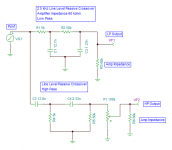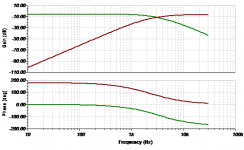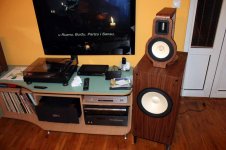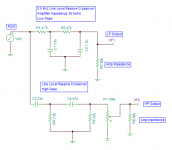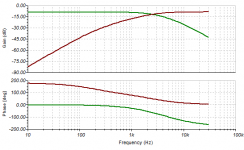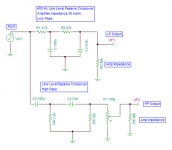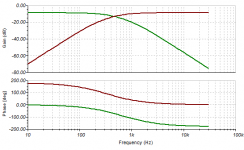I have this kit from sure, which uses TPA3122. I think it sounds very good. My initial impressions with the big-inductor 2.1 kit is that there is not a big difference in sound-quality. Also this kit is very nice for tweaking. Nice, big PCB with only through-hole components.
So fare I have only added better input-caps. If someone has ideas for other improvements I'd like to hear them.
2 X 15Watt Class D Audio Amplifier DIY Kit - TPA3122_DIY Kits_Audio Amplifier and other Audio Boards_Audio_Sure Electronics' Webstore
So fare I have only added better input-caps. If someone has ideas for other improvements I'd like to hear them.
2 X 15Watt Class D Audio Amplifier DIY Kit - TPA3122_DIY Kits_Audio Amplifier and other Audio Boards_Audio_Sure Electronics' Webstore
Passive Line Level XO (PLLXO) for TPA3116D2
Since these amps are so cheap, it naturally makes sense to use them for bi-amping with a passive line level cross-over. I used the spreadsheet from here http://www.t-linespeakers.org/tech/filters/passiveHLxo.html to calculate values for a 2.5 kHz XO. According to the TI literature, the TPA3116D2 has an input impedance of 60 kohm when gain is set at the medium 26 dB level. Based on the results of the spreadsheet, I plugged that into the free Spice modeling program called TINA from TI to confirm the results. It looks pretty good with a 12 dB slope. Best of all these line level parts cost pennies and the cost of the TPA3116D2 is less than passive speaker level XO. I added a 100k pot leading to the tweeter amp to adjust levels to match (like an L-pad). The XO has an inherent loss of -6dB, but if you drive this with line level outs from a CD player, or better, use the headphone-out jack as a variable level preamp, this should not be an issue. I have never built one of these before so wanted to get your feedback if you have done this. I plan to use the amps to drive a coaxial Eminence Beta 12CX and attached compression driver. I have heard that XO at 2.5kHz is good and avoids cone breakup.
Thanks,
X
Here is the circuit:
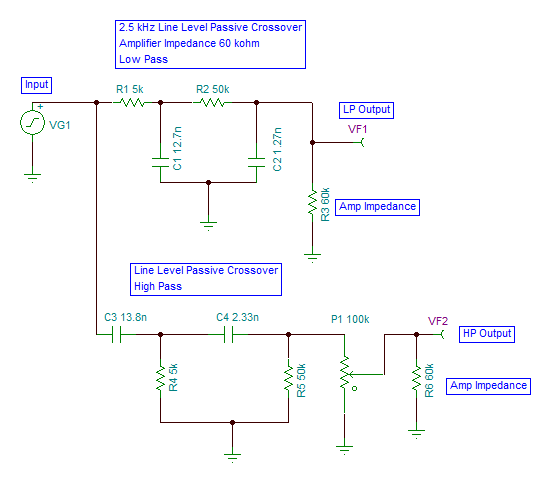
Here is the high pass and low pass gain:
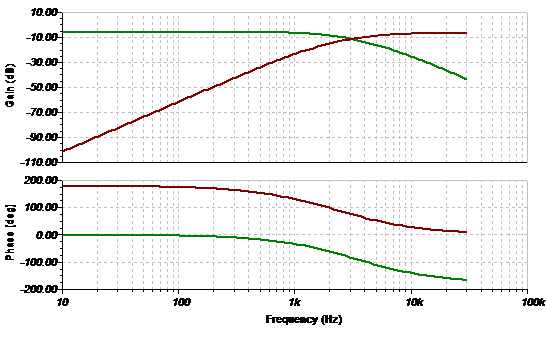
Since these amps are so cheap, it naturally makes sense to use them for bi-amping with a passive line level cross-over. I used the spreadsheet from here http://www.t-linespeakers.org/tech/filters/passiveHLxo.html to calculate values for a 2.5 kHz XO. According to the TI literature, the TPA3116D2 has an input impedance of 60 kohm when gain is set at the medium 26 dB level. Based on the results of the spreadsheet, I plugged that into the free Spice modeling program called TINA from TI to confirm the results. It looks pretty good with a 12 dB slope. Best of all these line level parts cost pennies and the cost of the TPA3116D2 is less than passive speaker level XO. I added a 100k pot leading to the tweeter amp to adjust levels to match (like an L-pad). The XO has an inherent loss of -6dB, but if you drive this with line level outs from a CD player, or better, use the headphone-out jack as a variable level preamp, this should not be an issue. I have never built one of these before so wanted to get your feedback if you have done this. I plan to use the amps to drive a coaxial Eminence Beta 12CX and attached compression driver. I have heard that XO at 2.5kHz is good and avoids cone breakup.
Thanks,
X
Here is the circuit:

Here is the high pass and low pass gain:

Attachments
Last edited:
I have a correction to post #385: the impedance of the TPA3116D2 is 60kohm at gain setting of 20dB. At 26dB impedance is 30k, so the above circuit would have to be reworked with appropriate value, or change gain setting resistors on amp to reduce gain to 20dB. The higher input impedance works better with the PLLXO.
No, more like 400-500hz... BetsyK would be on the bass box , in small OB , circular 12"diam. maybe... Something like ZM&wise-guys did with Sonido fullrange an 12"bass,
Sonido MLTL & OB - Stranica 10 - Zvu?nici - diyAudio.rs ,post186
Sonido MLTL & OB - Stranica 10 - Zvu?nici - diyAudio.rs ,post186
Attachments
No, more like 400-500hz... BetsyK would be on the bass box , in small OB , circular 12"diam. maybe... Something like ZM&wise-guys did with Sonido fullrange an 12"bass,
Sonido MLTL & OB - Stranica 10 - Zvu?nici - diyAudio.rs ,post186
I ran a case for 400 Hz in the spreadsheet but when I ran the simulation in Tina, it is more like 450 Hz - should be OK. This is assuming you are using the 26 dB amp gain for input impedance of 30 k ohm.
Circuit
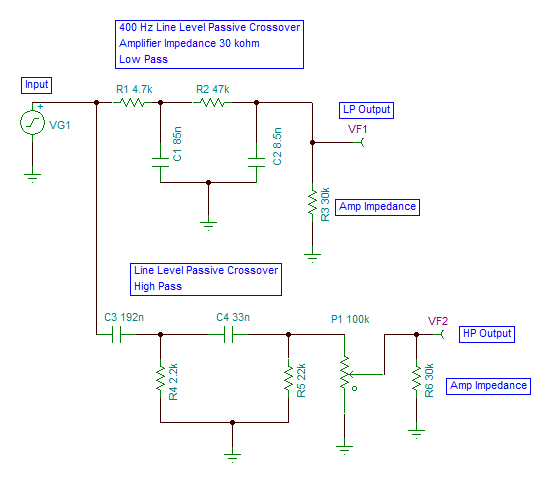
Gain/Phase Plot
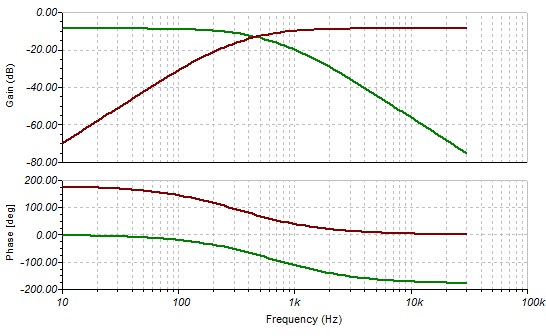
Attachments
the input resistor of tpa3116 has tolerance as high as +/-20%. For precise cutoff frequency you can insert buffer in between and use a high precision resistor to ground.
Good idea. I think the 2.1 version has a built in preamp which could serve as a buffer, and one could replace the input resistors with high precision ones. Adding a buffer to the 2.0 version sort of negates the simplicity of a PLLXO.
Stupid question: does it make any difference to setup one board using left channel for HF and right channel for Lf for each speaker instead of one stereo board for Hf and another one for Lf.
Great question actually. If stereo crosstalk separation is your ultimate goal it is actually better to keep left and right in discrete "mono blocks". As the physical size of the IC is small there is inevitably some channel crosstalk (probably in audible to normal ears). This may also simplify construction of the boxes and reduce wiring crossing back and forth.
Stupid question: does it make any difference to setup one board using left channel for HF and right channel for Lf for each speaker instead of one stereo board for Hf and another one for Lf.
When I bi-amp, I usually prefer "vertical bi-amping" so that I can place the amp very close to the speaker and use short speaker cables.
I would suggest trying both ways and see which way you prefer.
Attachments
Great question actually. If stereo crosstalk separation is your ultimate goal it is actually better to keep left and right in discrete "mono blocks". As the physical size of the IC is small there is inevitably some channel crosstalk (probably in audible to normal ears). This may also simplify construction of the boxes and reduce wiring crossing back and forth.
There's also the benefit that the current capacity of the chip is more or less limited by the cooling pad and not so much by the output transistors on the chip, so you could conceivably run the amp to 60-70W in one channel and 30-40 in the other.
Regarding bi-amping, I will use together with a Minidsp 2x4 kit. Extreme flexibility, great price.
It will also help to test and develop a future passive crossover with quality parts.
And then, I'll use the 3116 as monoblocks, with two 24V 5A SMPS.
This sounds like a really cool project. Please post some pics if possible.
Foe all you guys out their using this great little amp. Consider combining it with a Pass Pre B1. Both work off of a 24 DC supply. Pass can easily (and gets better, less THD) work with up to 36 volts DC. Not sure if the 3116 could take this, perhaps with a good heat sink. Any thoughts!!
The 3116 has an overvoltage shutdown at 27V +0%/-10%.
- Home
- Amplifiers
- Class D
- TPA3116D2 Amp
